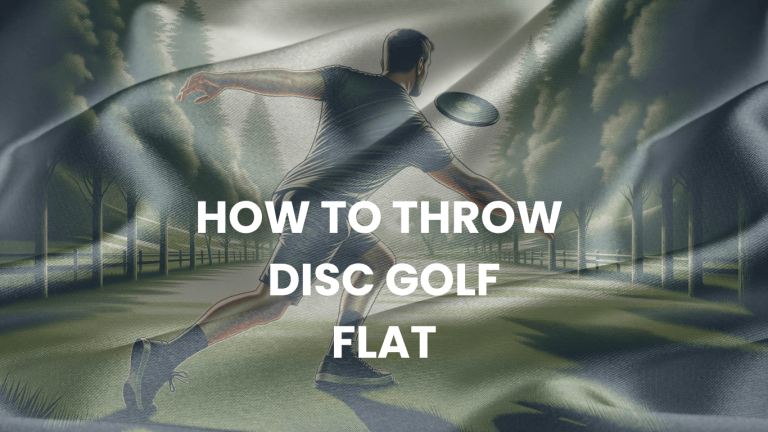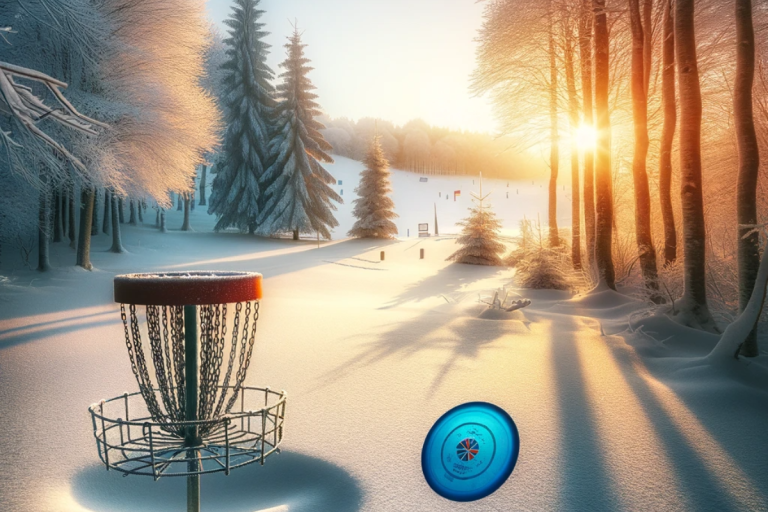How To Throw A Roller In Disc Golf? Master the Art of Throwing a Roller in Disc Golf – Step-by-Step Guide!
Throwing a roller in disc golf isn’t just a skill—it’s an art form that I’ve come to love. I remember the first time I watched a disc dance down the fairway, curving and rolling past obstacles, it seemed almost magical. This technique isn’t just about power; it’s a blend of precision, timing, and understanding the disc’s behavior. Through my journey, I’ve discovered that mastering the roller can turn a tricky course into an ally, working with the landscape to gain those extra yards.
Whether you’re a seasoned player or new to the sport, I’m excited to share the nuances of executing a flawless roller. Stick with me, and let’s unravel the secrets to adding this dynamic throw to your disc golf repertoire.
How To Throw A Roller In Disc Golf?
When I first gripped a disc golf driver, the concept of the roller seemed like a distant trick, reserved for the pros. Yet, as I delved into the game’s intricacies, I learned that throwing a roller is a pivotal skill every enthusiast should know. It’s about reading the terrain, harnessing the right disc, and releasing it into a dance with gravity and spin.
I’ve experienced the thrill of watching my roller cut through the air, then hug the ground, turning a challenging shot into an advantage. In this guide, I’ll walk you through each step to master this essential move, sharing insights that I’ve gathered along the fairways. So, let’s roll into the world of disc golf together and transform your game with the power of the roller throw.
Introduction to Disc Golf
So, you’ve heard of golf, but when someone threw “disc” into the mix, I bet it caught your attention. Disc golf is much like traditional golf, but instead of balls and clubs, we use discs and aim for metal baskets. The objective? Complete the course in the fewest throws possible. It’s a game where precision meets leisure, and anyone can play.
The Roller
Now, throwing a roller in disc golf, that’s where things get interesting. This isn’t your standard fairway toss. It’s a strategic move, a throw that lands the disc on its edge, rolling it towards the target instead of flying through the air. It can navigate tight spots and cover distance like no aerial shot can. Learning this technique was a game-changer for me; it can snake down paths and around trees, making the course your canvas.
Decoding the Roller Throw
Ever stumbled upon a shot in disc golf that made you think, “There’s no way I can fly a disc through that?” That’s where rolling comes into play. Picture this: instead of the disc soaring and dipping, it hits the ground, rim first, and charges forward on an epic roll. I’ve had my fair share of ‘aha’ moments when a well-placed roller covered more ground than any air shot could.

When to Roll with It
I can tell you, nothing beats the roller throw when you’re faced with a low ceiling of branches or need to hook around a sharp bend. It’s like that secret passage in a video game that bypasses all the obstacles. One time, I was stuck behind a thicket so dense, the only clear path was on the ground, and guess what? The roller was my trusty sidekick that got me out.
The Roller Throw Mechanics
Getting into the nitty-gritty, it’s all about the angle, the disc choice, and your arm movement. I had to practice the flick of the wrist, the point of release, and visualize the disc’s path. It’s like bowling a strike; everything needs to align for that satisfying roll to the basket. I’ll share more on that, so by the end, you’ll be throwing rollers that make the course seem like it was designed just for you.
You May Also Like: What is Disc Golf and How Is It Played?
Picking Your Roller Disc
When I first tried to throw a roller in disc golf, I quickly learned that not all discs are created equal. Finding the right disc for the job is like picking the right guitar for a gig; it’s got to suit the tune you’re playing. A disc with the right weight and shape makes all the difference when you’re aiming to roll along the fairway instead of taking flight.
Why Disc Specs Are Crucial
Now, let’s talk about weight and shape. A heavier disc? It’ll plow through the grass with gusto. A lighter one might just dance on top like a ballet dancer, covering more ground. And the shape – a flatter disc tends to stay upright longer, making it ideal for those long, drawn-out rolls. I’ve got discs in my bag that are just for rollers; they’re my secret weapon when the going gets tough.
Tailoring Your Throw
You see, personalizing your disc choice is like a chef picking a knife. It’s personal. It’s about how it feels when you hold it, how it responds to your throw, and how it behaves on the terrain. I’ve tossed enough discs to know that the right one feels like an extension of my own arm. It’s all about that perfect balance that complements your style and the course you’re conquering. Let’s get you set up with your roller arsenal, and you’ll be throwing with confidence in no time.
Unraveling the Aerodynamics
Whenever I launch a roller throw in disc golf, I’m actually playing with aerodynamics. It’s fascinating how a disc can transform from a glider in the air to a wheeler on the ground. In the air, it’s all about lift and drag, but on the ground, the game changes. It becomes a battle against friction and maintaining momentum as the disc rolls.
Spin and Angle
For a roller to truly work its magic, spin and angle come into play like peanut butter and jelly – perfect together. I learned that a disc needs the right amount of spin to stay upright and the right release angle to ensure it travels the intended path. Too vertical and it’ll cut left too soon, too flat and it may not roll at all. It’s about that sweet spot, and boy does it feel good when you hit it just right.

Surface Matters
The ground itself is a player in this game. I’ve watched my rollers sprint on hard-packed dirt and slog through tall grass. Different textures can make or break a roller’s performance. It’s a reminder that every throw is unique, and how a disc interacts with the terrain can be the difference between a tap-in birdie and a tricky upshot. Knowing the ground conditions is crucial, and it’s an aspect of the roller throw I always pay close attention to.
Mastering the Grip
Getting the grip right feels as crucial as choosing the right paintbrush for a canvas. I personally go for a firm backhand grip when setting up for a roller. The disc rests comfortably in my hand, with my fingers snugly underneath and my thumb pressing down on top. This isn’t just any grip; it’s your connection to the disc, so it has to be secure without straining your muscles.
Stance and Footwork
Your body stance is your foundation. I plant my feet shoulder-width apart, knees slightly bent, like I’m a quarterback ready to make a play. The footwork is a dance – a rhythmical approach that starts slow and accelerates. I lead with my dominant foot, step forward, and pivot, ensuring each step is deliberate. This isn’t just walking; it’s a choreographed routine that sets the stage for a powerful throw.
Run-Up and Release
The run-up is where the momentum builds. I start at a measured pace and drive forward, my eyes locked on my line. As I reach the release point, it’s all about timing. I uncoil, transferring the energy from my run-up through my body, to my arm, and finally to the disc. Releasing the disc with a slight upward tilt ensures it hits the ground at the right angle to begin its roll.
You May Also Like: How To Play Disc Golf For Beginners?
The Art of Follow-Through
Even after the disc leaves my hand, the story isn’t over. The follow-through is where I ensure the disc’s journey continues as planned. It’s a sweeping motion that helps maintain accuracy and adds a little extra oomph to the disc’s roll. Just like watching your ball in bowling or following through with a golf club, this motion is about consistency and making sure your shot ends up where you want it.
Common Mistakes and How to Avoid Them
Improper Disc Angle at Release
Let’s face it, we’ve all been there – releasing the disc with the wrong angle. It’s frustrating when it sails sky-high or digs straight into the ground. I’ve learned it’s about precision; even a few degrees can make a world of difference. So here’s what I do: I practice releasing the disc flat for a sky roller or with a slight angle for that perfect ground-hugging roll. Consistency here is key.
Incorrect Body Mechanics
Throwing a roller isn’t just about arm strength – it’s a full-body affair. Initially, I made the mistake of not engaging my core or aligning my shoulders. I focus now on aligning my shoulders with my target line and engaging my core to maintain balance. This isn’t a mere throw; it’s a kinetic chain reaction from the ground up, ending at the fingertips.
Poor Timing of the Throw
Timing is everything. Release too early or too late, and the disc won’t roll as intended. I count my steps during the run-up, timing the release to happen just as my lead foot hits the ground. This isn’t just a throw; it’s a rhythmic dance with the disc.
Advanced Techniques and Strategies
Adapting the Roller Throw to Different Terrains
Terrain can be a roller’s friend or foe. I’ve adapted my throws to match the ground I’m playing on. For a rugged terrain, I use a disc with a stronger edge to maintain direction. It’s like choosing the right tires for the road; match the tread to the trail for the best ride.
Cut Roller vs Sky Roller
The cut roller dives quickly, while the sky roller sails before it hits the ground. I decide based on obstacles and wind. A cut roller for narrow fairways and a sky roller when I’ve got space to play with. It’s like a chess game; each throw is a strategic move.

Managing Wind and Weather Conditions
Wind can wreak havoc on a roller. I’ve learned to read the breeze, adjusting my throw to compensate. When the wind is against me, I throw lower to keep control. Think of it like sailing; you adjust your sails to the wind, not fight against it.
Practice Drills for Perfecting the Roller Throw
Drills for Grip and Release
I practice my grip by repeatedly picking up discs from the ground, mimicking the release motion. It’s like a musician practicing scales, getting the muscle memory down.
Exercises for a Stronger Throw
To strengthen my throwing arm, I incorporate resistance bands into my workouts. It’s like gearing up for battle; I’m fortifying my arm for the fight.
Techniques for Accuracy and Control
For better accuracy, I set up targets and practice hitting them with my rollers. It’s like playing darts; each throw aims for the bullseye.
Learning from the Pros
Analyzing Professional Throws
I watch videos of pros, studying their form and technique. It’s like a student analyzing a master’s painting, looking for strokes to emulate in their own work.
Tips from Experienced Players
I’ve chatted with seasoned players, soaking up their advice. It’s like gathering wisdom from elders, each nugget of knowledge is a tool for improvement.
Applying Professional Strategies
Applying what I’ve learned from pros is transformative. Each strategy is like a new ingredient in my recipe, adding flavor to my game.
Conclusion
In wrapping up, nailing the roller throw in disc golf can be a game-changer for players at any level. I’ve walked this path, stumbled, and learned. It’s a blend of finesse, physics, and a touch of personal flair. Every throw teaches me something new and adds another story to my disc golf journey. Keep it whirling!
FAQs
Q1: What’s the best way to grip the disc for a roller?
Answer:
Grip it like you mean it – firm and confident, using a power grip to ensure it rolls, not flies.
Q2: How can I stop my roller from curving too much to the left?
Answer:
Keep your wrist straight; it’s like steering a bike, slight adjustments lead to a smoother ride.
Q3: Why does my roller lose speed too quickly?
Answer:
Give it more angle and snap – think of skipping a stone, the flick of the wrist is what sends it gliding.







